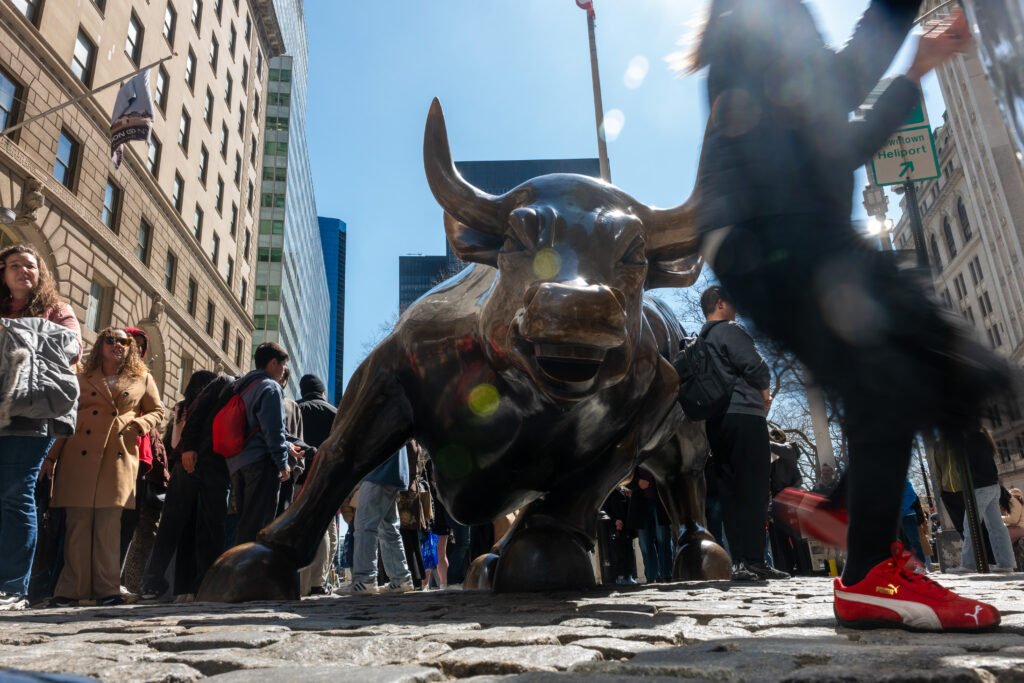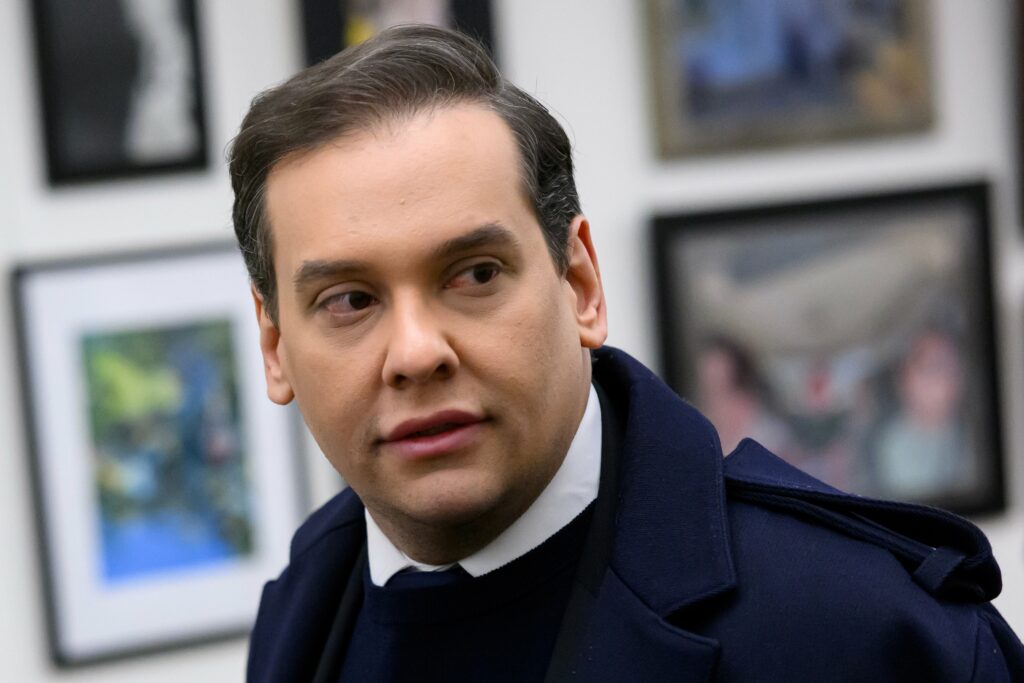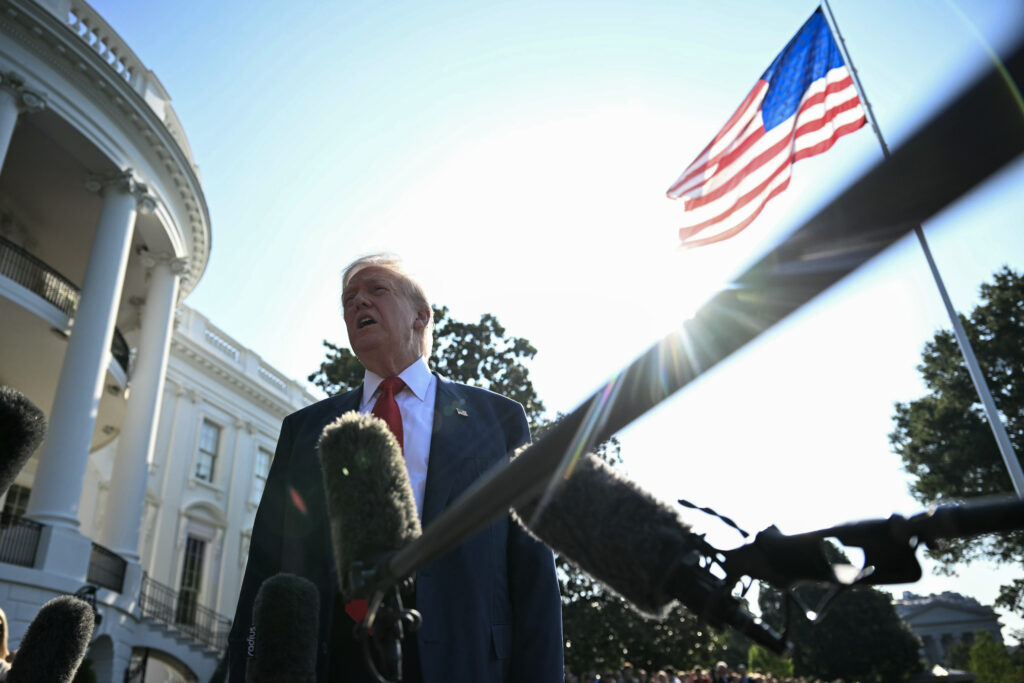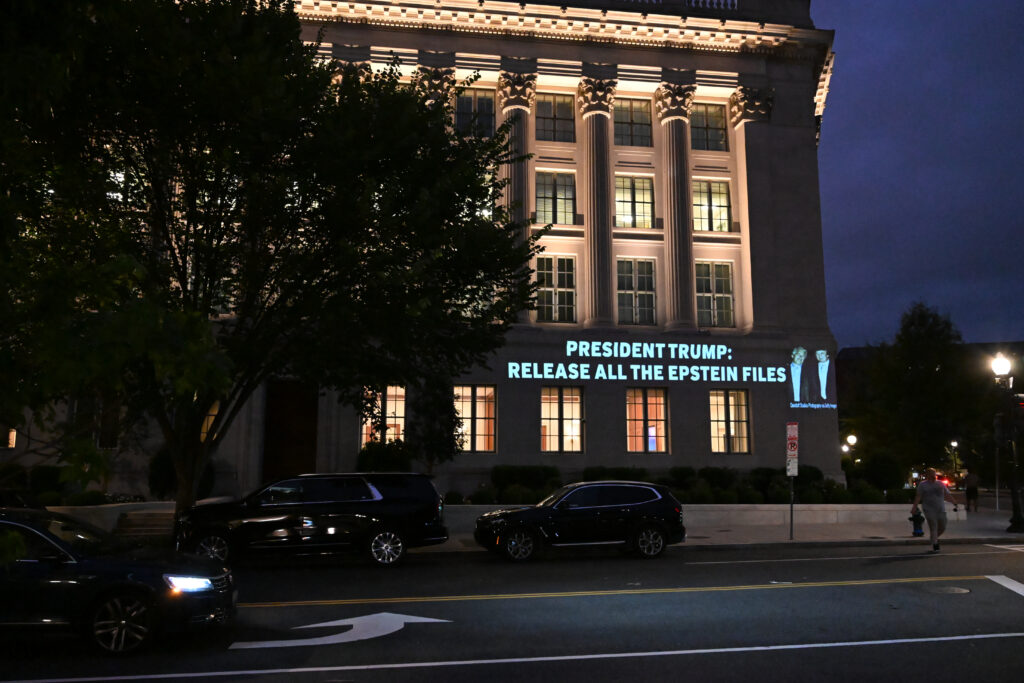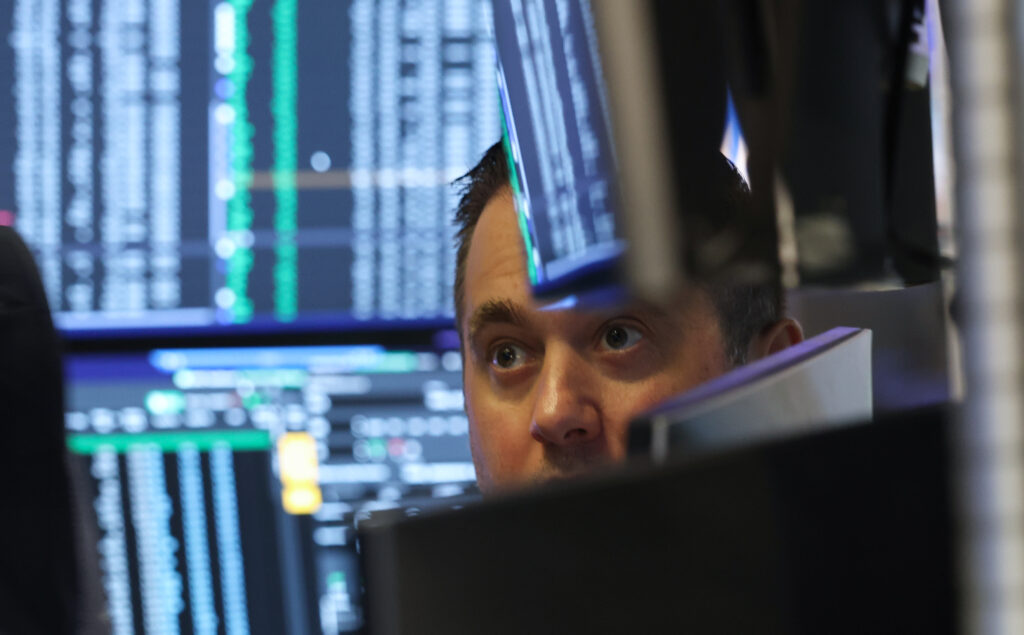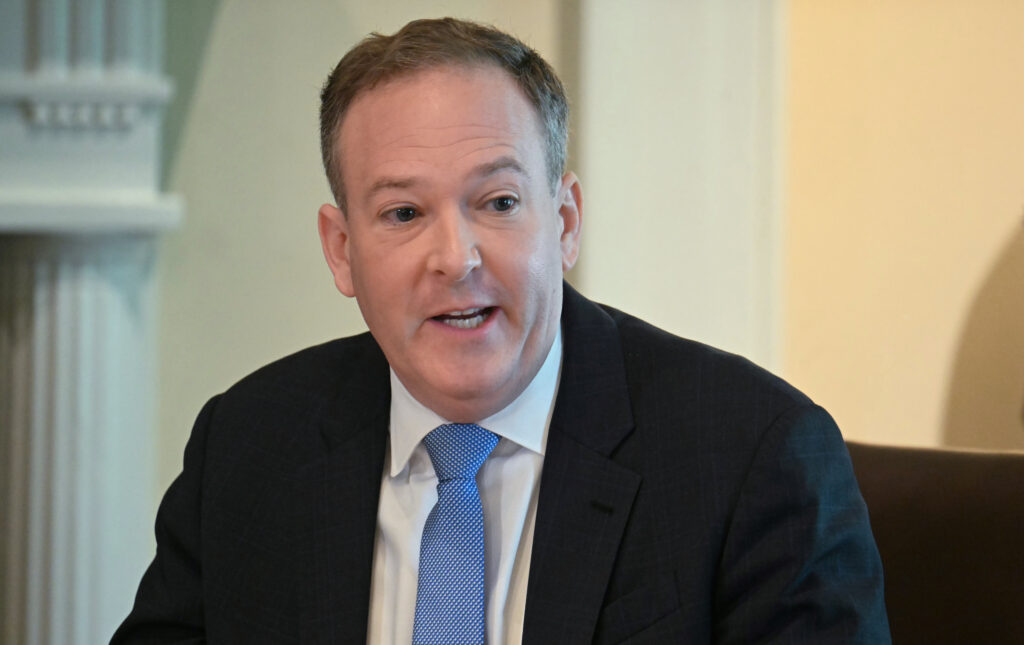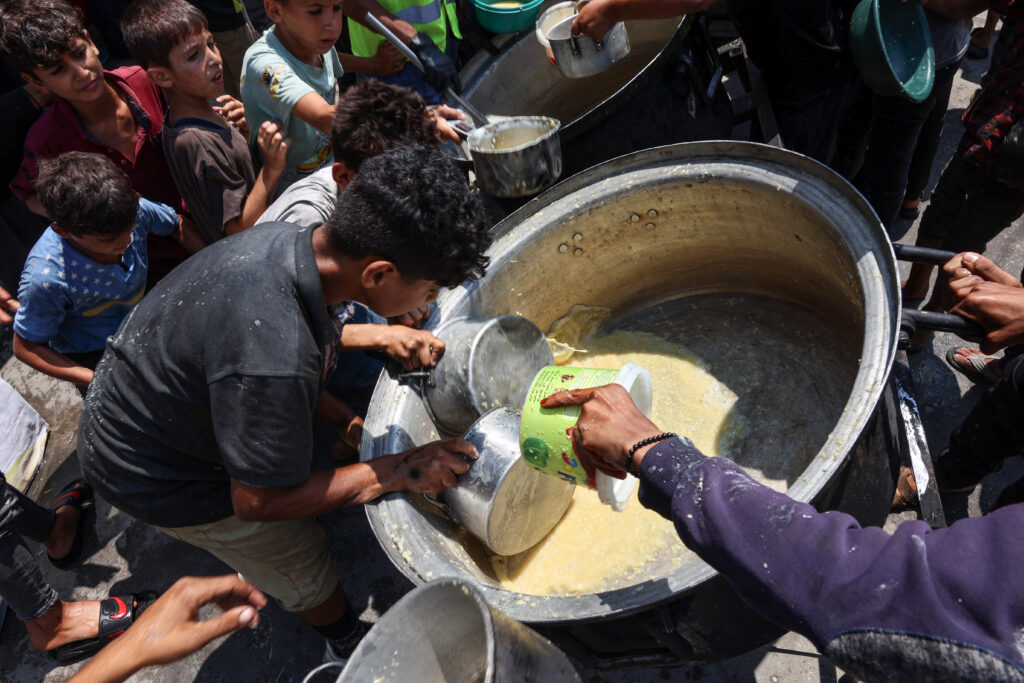US stocks end at records as markets eye tariff deadline
Wall Street stock indices ended at fresh records Friday as US investors bet on additional trade deals following this week’s breakthrough with Japan.US President Donald Trump cautioned that striking a deal with the European Union to reduce import tariffs will be a challenge. Trump has set an August 1 deadline for an accord.”I would say that we have a 50/50 chance, maybe less than that, but a 50/50 chance of making a deal with the EU,” Trump told reporters at the White House Friday.But US investors have adopted an optimistic stance about further accords given Trump’s record of suspending or delaying the most onerous tariffs. The S&P 500 finished at a fifth straight record and the tech-rich Nasdaq at a third straight record, capping an upbeat week. Equity markets elsewhere were more subdued.London, after a strong run on positive corporate news, finished slightly lower as did Frankfurt, while Paris closed just ahead after Asia lost ground.”There is no unifying theme across financial markets this month — instead markets are moving to the beat of their own drums,” concluded Kathleen Brooks, research director at XTB.Sentiment had been lifted earlier in the week by the announcement of a Japan-US deal, as well as signals that the EU could be closing in on its own accord with Washington.The “momentum has not been kept up, and European stocks are weaker at the end of the week,” noted Brooks.The EU is still forging ahead with contingency plans in case talks fail, with member states approving a 93 billion-euro ($109 billion) package of retaliatory counter-tariffs.With few positive catalysts to drive buying, Asian markets turned lower heading into the weekend.Tokyo retreated after a two-day rally and Hong Kong declined following five days of gains. Shanghai was also down. The dollar gained against major currencies, a reversal of the trend throughout much of 2025. The dollar fell the most in the first six months of 2025 since 1973.Trump said Friday that a weaker dollar can boost exports and tourism. “It doesn’t sound good, but you make a hell of a lot more money with a weaker dollar, not a weak dollar, but a weaker dollar, than you do with a strong dollar,” he told reporters at the White House.In corporate news, German auto giant Volkswagen said US tariffs had cost it 1.3 billion euros ($1.5 billion) in the first half of the year as it reported falling profits.After an initial drop, shares in the carmaker rose four percent in Frankfurt. German sportswear maker Puma saw its shares tumble around 16 percent after slashing its sales forecast and warning of a full year loss.Intel dropped 8.5 percent after reporting a $2.9 billion loss as it announced further cost-cutting initiatives. The company said it has cut about 15 percent of its workforce.- Key figures at around 2030 GMT -New York – Dow: UP 0.5 percent at 44,901.92 (close)New York – S&P 500: UP 0.4 percent at 6,388.64 (close)New York – Nasdaq Composite: UP 0.2 percent at 21,108.32 (close)London – FTSE 100: DOWN 0.2 percent at 9,120.31 (close)Paris – CAC 40: UP 0.2 percent at 7,834.58 (close)Frankfurt – DAX: DOWN 0.3 percent at 24,217.50 (close)Tokyo – Nikkei 225: DOWN 0.9 percent at 41,456.23 (close)Hong Kong – Hang Seng Index: DOWN 1.1 percent at 25,388.35 (close)Shanghai – Composite: DOWN 0.3 percent at 3,593.66 (close)Dollar/yen: UP at 147.68 yen from 147.01 yen on ThursdayEuro/dollar: DOWN at $1.1738 from $1.1749Pound/dollar: DOWN at $1.3431 from $1.3510Euro/pound: UP at 87.40 pence from 86.97 penceWest Texas Intermediate: DOWN 1.3 percent at $65.16 per barrelBrent North Sea Crude: DOWN 1.1 percent at $68.44 per barrel
Disgraced US ex-congressman Santos reports to prison
Disgraced former Republican lawmaker George Santos, who was expelled from the US Congress for using stolen donor cash to bankroll a lavish lifestyle, reported to prison Friday to start his seven-year sentence, authorities said.Santos, 37, had pleaded guilty to wire fraud and identity theft for his elaborate grifting while a lawmaker representing New York.He turned himself in Friday at the federal prison in Fairton, New Jersey, the Bureau of Prisons told AFP.Despite his guilty plea, prosecutors insisted Santos’s social media showed his claims of remorse “ring hollow” and Judge Joanna Seybert in April handed down a sentence of seven years and three months.The downfall of the congressman from Long Island came after it was revealed he had fabricated almost his entire backstory including his education, religion and work history.Santos was elected to the US House of Representatives in 2022 and indicted the following year for stealing campaign donors’ identities and using their credit cards, among other charges.Santos used the stolen funds for Botox treatments and the OnlyFans porn website, as well as luxury Italian goods and vacations to the Hamptons and Las Vegas, according to an investigation by a congressional ethics committee.Santos’s bizarre biographical fabrications included claiming to have worked for Goldman Sachs, being Jewish and having been a college volleyball star.He was ultimately doomed by the congressional probe that found overwhelming evidence of misconduct and accused him of seeking to “fraudulently exploit every aspect of his House candidacy.”Santos was expelled from the House in 2023, becoming only the third person to be ejected as a US lawmaker since the Civil War, a rebuke previously reserved for traitors and convicted criminals.
Trade on agenda as Trump lands in Scotland for diplomacy and golf
US President Donald Trump landed in Scotland on Friday for a five-day visit set to mix diplomacy, business and leisure, as a huge UK security operation swung into place amid planned protests near his family-owned golf resorts. The president, whose mother was born in Scotland, will split his time between two seaside golf courses bearing his name, in Turnberry on the southwestern coast and Aberdeen in the northeast.Air Force One, carrying the president and White House staff, touched down at Prestwick Airport near Glasgow shortly before 8:30 pm (1930 GMT). Police officers lined surrounding streets and several hundred curious Scots came out hoping for a glimpse of the US leader as he then made his way to Turnberry by motorcade.Trump has no public events scheduled for Saturday and is expected to play golf at his picturesque resort, before meeting EU chief Ursula von der Leyen on Sunday for trade talks.Trump is also due to meet UK Prime Minister Keir Starmer during the trip.He said the meeting would be “more of a celebration than a workout,” appearing to row back on previous comments that a bilateral trade deal struck in May needed “fine tuning”.”The deal is concluded,” he told reporters on the tarmac at Prestwick.But the unpredictable American leader appeared unwilling to cede to a UK request for reduced steel and aluminium tariffs.Trump has exempted British exports from blanket 50 percent tariffs on both metals, but the fate of that carve-out remains unclear.”If I do it for one, I have to do it for all,” Trump said in Washington before embarking on his flight, when asked if he had any “wiggle room” for the UK on the issue. The international outcry over the conflict in Gaza may also be on the agenda, as Starmer faces growing pressure to follow French President Emmanuel Macron and announce that Britain will also recognise a Palestinian state.- Protests -Trump is due to return to the UK in September for a state visit — his second — at the invitation of King Charles III, which promises to be lavish.During a 2023 visit, Trump said he felt at home in Scotland, where his mother Mary Anne MacLeod grew up on the remote Isle of Lewis before emigrating to the United States at age 18.”He’s original, he does things the way he wants to. I think a lot of our politicians could take a good leaf out of his book,” 45-year-old Trump fan Lisa Hart told AFP as she waited to see his plane touch down.But the affection between Trump and Scotland is not always mutual.Residents, environmentalists and elected officials have voiced discontent over the Trump family’s construction of a new golf course, which he is expected to open before he departs the UK on Tuesday.Police Scotland, which is bracing for mass protests in Edinburgh and Aberdeen as well as close to Trump’s golf courses, have said there will be a “significant operation across the country over many days”.Scottish First Minister John Swinney, who will also meet Trump during the visit, said the nation “shares a strong friendship with the United States that goes back centuries”.Trump has also stepped into the sensitive debate in the UK about green energy and reaching net zero, with Aberdeen being the heart of Scotland’s oil industry.In May, he wrote on his Truth Social platform that the UK should “stop with the costly and unsightly windmills” as he urged incentivising drilling for oil in the North Sea.- US discontent -The trip to Scotland puts physical distance between Trump and the latest twists in the case of convicted sex offender Jeffrey Epstein, the wealthy financier accused of sex trafficking who died in prison in 2019 before facing trial.In his heyday, Epstein was friends with Trump and others in the New York jet-set, but the president is now facing backlash from his own MAGA supporters who demand access to the Epstein case files.Many support a conspiracy theory under which “deep state” elites protected rich and famous people who took part in an Epstein sex ring. But Trump is urging his supporters to move on from the case.The Wall Street Journal, which published an article detailing longstanding links between Trump and the sex offender, is being punished by the White House.Its reporting team plans to travel to Scotland on their own and join the White House press pool. But it has now been denied a seat on Air Force One for the flight back home.While Trump’s family has undertaken many development projects worldwide, the president no longer legally controls the family holdings.But opponents and watchdog groups have accused him of having many conflicts of interest and using his position as US president to promote private family investments, especially abroad.aue-jkb-jj-pdh/dc
Fake AI photos of Trump with Epstein flood internet
Fake AI-generated photos and videos purporting to show Donald Trump and convicted sex offender Jeffrey Epstein socializing with underage girls have flooded social media, racking up millions of views, researchers said Friday.The surge in deepfakes comes as the US president — frequently photographed with Epstein during their 15-year friendship — attempts to distance himself from the disgraced financier, who died in jail in 2019 while awaiting trial on sex trafficking charges. One widely circulated AI-generated video appears to show Trump and Epstein leering at a group of young girls dancing, with the song “Is it a Crime?” by the English band Sade added as background music.At least two other fake photos appear to show the pair on a couch alongside underaged girls.Another such photograph purports to shows Trump dancing with a teenage girl on Epstein’s private island. Overlaying the image is the caption: “Trump was in his 50’s when this was taken. What kind of man does that?”At least seven such AI-generated images and one video cumulatively garnered more than 7.2 million views across social media platforms, according to a conservative estimate by disinformation watchdog group NewsGuard.The watchdog said it used multiple detection tools, including Hive and IdentifAI, to establish that the content was fabricated using AI tools and the actual number of views was likely much higher than its manual tally of high-engagement posts.Trump’s ties to Epstein are extensive, and the pair were frequently pictured partying together during their friendship before they fell out in 2004 over a property deal.But there appear to be no known authentic photographs of the pair with underage girls or of Trump visiting Epstein’s private island in the Caribbean, NewsGuard said.AI slop — low-quality visual content generated using cheap and widely available artificial intelligence tools –- increasingly appears to be flooding social media sites, blurring the lines between reality and fiction.Many content creators on YouTube and TikTok offer paid courses on how to monetize viral AI slop on tech platforms, many of which have reduced their reliance on human fact-checkers and scaled back content moderation.AI-generated images of Trump spread rapidly after the FBI and Justice Department said in a July 7 memo that there was no proof that Epstein kept a “client list” of elite co-conspirators as conspiracy theorists have contended.Trump’s core Make America Great Again (MAGA) base erupted in anger over the memo, calling on the White House to release the so-called “Epstein files.”Some even within the Republican president’s own party have demanded the files be released, but his administration has declined to do so. Fake images appear to be gaining traction in that vacuum.The Wall Street Journal reported on Wednesday that the president’s name was among hundreds found during an official review of the files, though there has not been evidence of wrongdoing.Trump filed a $10 billion defamation suit against the newspaper last week after it reported that he had penned a sexually suggestive letter to Epstein for his 50th birthday in 2003.
Wall Street atteint de nouveaux sommets, rassurée sur le plan commercial
La Bourse de New York a terminé la semaine sur des nouveaux records vendredi, les investisseurs se montrant optimistes vis-à-vis des négociations commerciales et des résultats trimestriels. L’indice élargi S&P 500 (+0,40% à 6.388,64 points) a franchi un nouveau plus haut pour la cinquième séance d’affilé. L’indice Nasdaq (+0,24% à 21.108,32 points) a aussi atteint un nouveau sommet, tandis le Dow Jones a gagné 0,47%.”Ces records historiques sont soutenus par l’optimisme concernant les accords commerciaux et les solides résultats des entreprises” pour le deuxième trimestre, résume auprès de l’AFP Angelo Kourkafas, d’Edward Jones.A l’approche de la date butoir du 1er août, les investisseurs s’attendent à la conclusion d’accords concernant les droits de douane annoncés par le président américain Donald Trump.L’administration Trump compte pour l’heure cinq accords à son actif, avec le Royaume-Uni, le Japon, le Vietnam, l’Indonésie et les Philippines.Le président américain a affirmé vendredi que la probabilité que les Etats-Unis concluent un accord commercial avec l’Union européenne était de “50-50″.Selon plusieurs sources européennes, ce compromis prévoit des surtaxes douanières de 15% sur les exportations européennes à destination des Etats-Unis, avec des exemptions notamment sur l’aéronautique, les spiritueux ou certains médicaments. C’est bien en deçà des 30% que Donald Trump menace d’appliquer.La place américaine profite toujours des bonnes performances trimestrielles de certaines entreprises, à l’image de celles d’Alphabet, maison mère de Google (+0,53% à 193,18 dollars), qui a largement dépassé les attentes mercredi.”La semaine prochaine, plusieurs des +Sept Magnifiques+ (le surnom donné aux grands noms du secteur technologique, ndlr) publieront leurs résultats financiers, ce qui pourrait quelque peu perturber le calme estival”, commente M. Kourkafas. C’est le cas de Meta, maison mère de Facebook, ou encore du géant Amazon.”Tout accroc dans leurs résultats aura des répercussions sur l’ensemble du marché”, souligne Angelo Kourkafas.En outre, les acteurs du marché ont été rassurés par les données économiques publiées cette semaine, dont le recul des inscriptions au chômage pour la sixième période d’affilée.Wall Street suivra la semaine prochaine la réunion du comité de politique monétaire de la banque centrale des Etats-Unis (FOMC) à l’issue de laquelle les acteurs du marché s’attendent à ce que l’institution laisse ses taux inchangés, soit dans une fourchette comprise entre 4,25% et 4,50%.Pour Nancy Vanden Houten, d’Oxord Economics, “l’accent sera mis sur la politique monétaire” privilégiée par la Réserve fédérale pour les prochains mois.Sur le marché obligataire, le rendement des emprunts d’Etat américains à 10 ans se détendait légèrement vers 20H15 GMT, à 4,38% contre 4,41% la veille en clôture.A la cote, le groupe américain de semi-conducteurs Intel a glissé (-8,53% à 20,70 dollars) après l’annonce de pertes nettes de 2,9 milliards de dollars au deuxième trimestre, en grande partie dues au coût d’un important plan de départ.Le chausseur Deckers Outdoor a brillé (+11,35% à 116,85 dollars) grâce à une nette hausse des ventes des chaussures de course Hoka et des bottes Ugg. D’avril à juin, l’entreprise a réalisé un chiffre d’affaires de 964,5 millions de dollars (+17% sur un an) et un bénéfice net par action de 93 cents.L’assureur spécialisé dans la santé Centene a été recherché (+6,09% à 28,39 dollars) malgré des résultats moins bons qu’anticipé.
Trump administration expected to say greenhouse gases aren’t harmful
President Donald Trump’s administration is preparing to upend a foundational scientific determination about the harms of greenhouse gases that underpins the US government’s ability to curb climate change.A proposal from the Environmental Protection Agency (EPA) to change the so-called “Endangerment Finding” was sent to the White House on June 30, a spokesperson told AFP. An announcement is expected imminently. Here’s what to know — and what’s at stake if the finding is overturned.- What is the Endangerment Finding? -The Clean Air Act of 1970 empowered the EPA to regulate “air pollution which may reasonably be anticipated to endanger public health or welfare.”For decades, the law applied to pollutants like lead, ozone and soot.But as climate science around the dangers of heat-trapping greenhouse gases advanced in the 2000s, a coalition of states and nonprofit groups petitioned the EPA to include them under the law, focusing on motor vehicles.The issue reached the Supreme Court, which in 2007 ruled that greenhouse gases qualify as air pollutants and directed the EPA to revisit its stance.That led to the 2009 Endangerment Finding, which declared greenhouse gases a threat to public health and welfare, based on overwhelming scientific consensus and peer-reviewed research.”That 2009 finding formed the basis for all of EPA’s subsequent regulations,” Meredith Hankins, a senior attorney on climate and energy for the nonprofit Natural Resources Defense Council, told AFP.”They’ve issued greenhouse gas standards for tailpipe emissions from motor vehicles, smokestack emissions from power plants — all of these individual rulemakings trace themselves back to the 2009 Endangerment Finding.”- What is the Trump administration doing? -The Endangerment Finding has withstood multiple legal challenges, and although Trump’s first administration considered reversing it, they ultimately held back.But the finding is now a direct target of Project 2025, a far-right governance blueprint closely followed by the administration.In March, the EPA under Administrator Lee Zeldin announced a formal reconsideration of the finding.”The Trump Administration will not sacrifice national prosperity, energy security, and the freedom of our people for an agenda that throttles our industries, our mobility, and our consumer choice while benefiting adversaries overseas,” he said.The government is expected to undo the earlier finding that greenhouse gases endanger public welfare.It will argue that the economic costs of regulation have been undervalued — and downplay the role of US motor vehicle emissions in climate change.In fact, transportation is the largest source of US greenhouse gas emissions.”If vehicle emissions don’t pass muster as a contribution to climate change, it’s hard to imagine what would,” Dena Adler of the Institute for Policy Integrity at New York University told AFP.”It’s fatalistic to avoid taking the many actions that could cumulatively fix climate change, because none of them can individually solve the entire problem.”Since 1970, the United States has emitted more vehicle-based greenhouse gases than the next nine countries combined, according to an analysis by the Institute for Policy Integrity that will soon be published in full.- Could they succeed? -In March, the EPA said it would lean on recent court rulings, including a landmark 2024 decision that narrowed federal regulatory power.Still, legal experts say the administration faces an uphill battle.”It will take a few years for the rule to be finalized and wind its way up to the Supreme Court for review,” said Adler. “If EPA loses before the Supreme Court, it gets sent back, and EPA then gets it back to the drawing board” — by which time Trump’s term may be nearing its end.To succeed, the high court may need to overturn its own 2007 decision that led to the Endangerment Finding.None of the justices who wrote the majority opinion remain on the bench, while three dissenters — John Roberts, Clarence Thomas, and Samuel Alito — still serve, and could spearhead a drive to upend the original ruling.Even then, market forces may blunt the impact of any rollback.”Utilities making long-term investments and companies purchasing capital goods expected to be used for decades won’t base those decisions on short-term policy changes,” said John Tobin-de la Puente, a professor at Cornell University’s business school.That’s especially true when those swings run counter to business trends and could be undone by a future administration, he added.
Trump affirme que le Hamas “veut mourir” après l’échec des pourparlers sur Gaza
Le président américain Donald Trump a affirmé vendredi que le mouvement islamiste palestinien Hamas “veut mourir”, après l’avoir accusé de ne pas rechercher un accord sur un cessez-le-feu dans la bande de Gaza affamée et ravagée par plus de 21 mois de guerre.Le Premier ministre israélien Benjamin Netanyahu a annoncé, après l’échec des négociations, “étudier d’autres options pour ramener” les otages et “mettre fin au règne terroriste du Hamas”. Le mouvement islamiste a, lui, accusé l’émissaire américain Steve Witkoff de revirement pour “servir l’intérêt d’Israël”.Dans ce contexte d’accusations réciproques, un responsable israélien a annoncé la reprise “dans les prochains jours” des largages d’aides à Gaza, plongée dans un désastre humanitaire et où l’ONU et des ONG s’alarment d’une flambée de la malnutrition infantile et d’un risque de famine généralisée.Les bombardements israéliens ont entretemps continué, la Défense civile faisant état de 28 morts vendredi dans le territoire palestinien en proie à une guerre déclenchée par une attaque sans précédent du Hamas contre Israël le 7 octobre 2023.”Le Hamas ne voulait pas vraiment conclure un accord. Je pense qu’ils veulent mourir. Et c’est très, très grave”, a dit M. Trump.Son émissaire, M. Witkoff, a acté jeudi l’échec des pourparlers menés pendant plus de deux semaines à Doha entre Israël et le Hamas par l’intermédiaire du Qatar, des Etats-Unis et de l’Egypte. Il a, comme M. Netanyahu, retiré ses négociateurs en mettant en cause la bonne foi du Hamas.M. “Witkoff a vu juste. Le Hamas est l’obstacle à un accord de libération des otages” enlevés durant l’attaque du 7-Octobre, a dit M. Netanyahu.- “La catastrophe doit cesser” -Mais Bassem Naïm, un responsable du Hamas, a accusé M. Witkoff d’avoir changé d’avis. L’émissaire américain avait estimé “il y a seulement quelques jours” que les échanges étaient positifs et “les médiateurs avaient accueilli très positivement la réponse du Hamas”, a-t-il dit à l’AFP.Le Hamas, qui a pris le pouvoir en 2007, avait répondu à l’offre de trêve de 60 jours assortie d’une libération d’otages, en proposant des amendements concernant l’entrée des aides, le retrait israélien de Gaza et les garanties sur la fin de la guerre.Israël, qui refuse de donner de telles garanties, veut démanteler le Hamas, le chasser de Gaza et prendre le contrôle du territoire.L’armée israélienne assiège Gaza depuis octobre 2023 et contrôle tous ses accès, après y avoir lancé une offensive d’envergure en riposte à l’attaque du 7-Octobre. Début mars, Israël a interdit l’entrée des aides à Gaza, avant d’autoriser fin mai des quantités très limitées, entraînant de graves pénuries de nourriture, de médicaments et de carburant, et suscitant des critiques internationales croissantes. “A Gaza aujourd’hui, il n’y a pas de famine causée par Israël”, a affirmé le gouvernement Netanyahu.”La catastrophe humanitaire à Gaza doit cesser immédiatement”, ont exhorté Paris, Londres et Berlin, en appelant Israël à “lever immédiatement les restrictions sur l’acheminement de l’aide”.- “Aller au paradis” -Selon Médecins sans frontières, un quart des enfants âgés de six mois à cinq ans et des femmes enceintes et allaitantes examinés la semaine dernière par l’ONG à Gaza souffrent de malnutrition.”Près d’une personne sur trois ne mange pas pendant des jours”, affirme le Programme alimentaire mondial. “La famine commence à s’installer silencieusement à Gaza”, indique l’agence de l’ONU pour les réfugiés palestiniens. “Les enfants disent vouloir aller au paradis, parce qu’au moins, disent-ils, il y a à manger là-bas”, a déclaré le patron de l’ONU Antonio Guterres.”Les enfants pleurent, ils ont faim, ils veulent manger. Les gens passent trois jours sans nourriture”, a déclaré à l’hôpital Nasser à Khan Younès, dans le sud de Gaza, Fatima al-Shawaf, qui a perdu un proche tué en attendant de l’aide.A l’hôpital al-Chifa de Gaza-ville (nord), des femmes pleurent la mort d’un bébé de 14 mois, transporté avec d’autres victimes après une frappe sur une école abritant des déplacés, selon des images de l’AFP. “On était assis, les enfants jouaient et des gens priaient quand un missile est tombé sur les enfants. Certains ont été déchiquetés. Ce n’étaient que des enfants affamés”, lance Maha Adwan, une proche du bébé.L’attaque du 7-Octobre a entraîné côté israélien la mort de 1.219 personnes, en majorité des civils, selon un décompte de l’AFP réalisé à partir de données officielles. Sur les 251 personnes enlevées, 49 restent otages à Gaza, dont 27 ont été déclarées mortes par l’armée.Les représailles israéliennes ont fait 59.676 morts à Gaza, majoritairement des civils, selon des données du ministère de la Santé à Gaza, jugées fiables par l’ONU.

